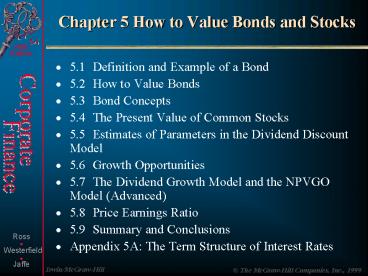Chapter 5 How to Value Bonds and Stocks
1 / 12
Title: Chapter 5 How to Value Bonds and Stocks
1
Chapter 5 How to Value Bonds and Stocks
- 5.1 Definition and Example of a Bond
- 5.2 How to Value Bonds
- 5.3 Bond Concepts
- 5.4 The Present Value of Common Stocks
- 5.5 Estimates of Parameters in the Dividend
Discount Model - 5.6 Growth Opportunities
- 5.7 The Dividend Growth Model and the NPVGO Model
(Advanced) - 5.8 Price Earnings Ratio
- 5.9 Summary and Conclusions
- Appendix 5A The Term Structure of Interest Rates
2
Valuation of Bonds and Stock
- First Principles
- Value of financial securities PV of expected
future cash flows - To value bonds and stocks we need to
- Estimate future cash flows size (how much) and
timing (when) - Discount future cash flows at an appropriate
rate
3
Pure Discount Bonds
- Information needed for valuing pure discount
bonds - Time to maturity (T) Maturity date - todays
date - Face value (F)
- Discount rate (r)
- 0 1 2 T
- --------------------------------------------
------ - F
- Value of a pure discount bond
- PV F / (1 r)T
4
Level-Coupon Bonds
- Information needed to value level-coupon bonds
- Coupon payment dates and Time to maturity (T)
- Coupon (C) per payment period and Face value (F)
- Discount rate
- 0 1 2 T
- -----------------------------------------
------ - Coupon Coupon Coupon F
- Value of a Level-coupon bond
- PV F / (1 r)T C x 1/r - 1 / r x (1
r)T - PV of face value PV of coupon payments
5
YTM, Bond Value, and Discount Rate
Bond Value and Discount Rate
1800
1600
1400
Bond Value
1200
1000
993.12
800
0
0.01
0.02
0.03
0.04
0.05
0.06
0.07
0.08
0.09
0.1
Discount Rate
6
Some Tips on Bond Pricing
- 1. Bond prices and market interest rates move in
opposite directions. - 2. When coupon rate YTM, price par value.
- When coupon rate gt YTM, price gt par value
(premium bond) - When coupon rate lt YTM, price lt par value
(discount bond) - 3. A bond with longer maturity has higher
relative () price change than one with shorter
maturity when interest rate (YTM) changes. All
other features are identical. - 4. A lower coupon bond has a higher relative ()
price change than a higher coupon bond when
interest rate (YTM) changes. All other features
are identical.
7
Common Stock Valuation
- Information needed to value common stocks
- Common Stock Dividends (Dt)
- Discount rate
- PV0 D1/(1 r)1 D2/(1 r)2 D3/(1 r)3
. . . forever. .
8
Case 1 Zero Growth
- Assume that dividends will remain at the same
level forever, i.e. D1 D2 Dt - Since future cash flows are constant, the value
of a zero growth stock is the present value of a
perpetuity - Pt Dt1 / r
9
Case 2 Constant Growth
- Assume that dividends will grow at a constant
rate, g, forever, i. e., - D1 D0 x (1g)
- D2 D1 x (1g), etc., etc.. and
- Dt D0 x (1g)t
- Since future cash flows grow at a constant rate
forever, the value of a constant growth stock is
the present value of a growing perpetuity - Pt Dt1 / (r - g)
10
Case 3 Differential Growth
- Assume that dividends will grow at different
rates in the foreseeable future and then will
grow at a constant rate thereafter. - To value a Differential Growth Stock, we need to
- Estimate future dividends in the foreseeable
future. - Estimate the future stock price when the stock
becomes a Constant Growth Stock (case 2). - Compute the total present value of the estimated
future dividends and future stock price at the
appropriate discount rate.
11
A Differential Growth Example (Problem 5.13)
- r 12 (required return)
- g1 g2 g3 8
- D0 2
- D1 2 x 1.08 2.16, D2 2.33, D3 2.52
- g4 gn 4
- Constant growth rate applies to D4
- -gt use Case 2 (constant growth) to compute P3
- D4 2.52 x 1.04 2.62
- P3 2.62 / (.12 - .04) 32.75
12
Problem 5.13 (concluded)
- Expected future cash flows of this stock
- 0 1 2 3
- ---------------------------- (r 12)
- D1 D2 D3 P3
- 2.16 2.33 2.52 32.75
- P0 2.16/1.12 2.33/1.122 35.27/1.123
28.89































